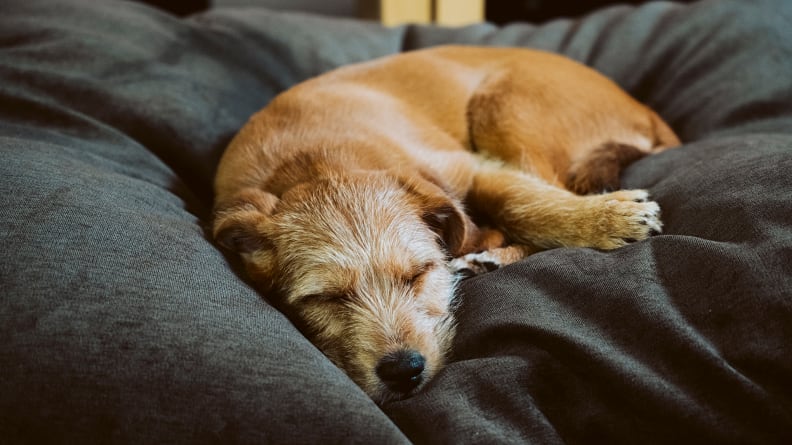Products are chosen independently by our editors. Purchases made through our links may earn us a commission.
Dog crates suffer from a bit of an image problem. With metal bars and locking mechanisms, we humans tend to see wire crates as cruel, menacing cages. But crate-training your puppy is actually the opposite of punishment—at least it should be.
For starters, dogs are den animals, and actually find comfort in dark and enclosed spaces. Crates are also helpful when housebreaking, since dogs don’t like to pee or poop where they sleep, plus they can serve as a home away from home when you’re on the road. Not to mention, they’re safer for everyone at home, rather than leaving your pup to roam free in the house when there’s no one around to observe.
That said, there’s a lot more to the process than buying a dog crate, placing your dog inside, locking the door, and being done with it. Without slowly, purposefully (and, above all, positively!) introducing your dog to their crate, they can come to look at it as a scary prison, as opposed to the peaceful den of tranquility it’s meant to be.
We turned to Jen Jones—a dog trainer, behavior specialist, and founder of Your Dog Advisor—for tips on how to crate-train your dog successfully.
Create a welcoming, safe space

Outfit the dog crate with a comfy dog bed to create a safe space.
Above all else, your dog’s crate should be comfortable. Otherwise, why should they want to spend any time in it? “Make sure there is a dog bed that fits well, doesn’t slide about, and still gives your dog adequate space to move,” Jones suggests. We tested the Midwest Homes bolster pet bed, and gave it a thumbs-up for its soft material, generous range of sizes, and slightly raised edge for head-resting,
It’s also important to be thoughtful about where you set up the crate. The area shouldn’t be too drafty or hot, and ideally, it will allow your dog to be in the same space as you (the living room, for instance) to lessen separation anxiety.
Introduce food and treats in the dog crate
“By feeding your dog in the crate, it gives them a space to eat their dinner in peace and allows them to form a positive association with the crate,” Jone says. “Crate means food and comfy space.”
When it’s not mealtime, reward your pup if you need them to voluntarily go into the crate. Says Jones: “You may need to start by throwing treats inside to encourage them to enter themselves, and follow up with more treats once they’re inside.”
It’s also helpful to offer your dog longer-lasting chews or treat-stuffed toys like Kongs to encourage them to stay in their crate for a longer amount of time. The classic toy comes in different sizes and strengths, including Kong Puppies designed for baby teeth and Kong Extreme, made of a super durable rubber for eager chewers.
Don’t close the door right away
Ultimately, you want the door closed. But when you first start crate-training, the goal is to create a positive association with the crate. That means allowing your dog to relax.
“Blocking your dog’s exit while you’re still teaching them can be too much, too soon,” Jones says. “The goal is to get them to go in and stay voluntarily, even with the door open.”
You’ll know your pup is comfortable with staying in the crate for longer stretches by signs such as laying down, relaxing, or even sleeping. Then, you can gradually open and close the door while they remain relaxed.
“Every time you close the door they should get a treat, and the same when you open the door. You should build up gradually, from just a few seconds of closure,” Jones explains.
Gradually build up time spent in the crate
Once you start closing the door, don’t immediately leave the house for lengthy errands. Even 10 or 15 minutes of alone time can cause panic if introduced too soon.
“Start with a short 10-second duration, then one minute long, then five minutes long, then 10 minutes long, and so on,” Jones says. “And, as before, every session should be paired with lots of yummy rewards.”
As soon as you’re ready to leave your dog in the crate for a longer period of time, it’s best to practice while you’re still in the house. That way, you’re able to observe and help if your pup gets seriously distressed.
“Sometimes you need to adjust your training schedule and take it back a notch or two if you are progressing too quickly,” Jones stresses. “Don’t leave them unsupervised until you are 100% certain that your dog is totally relaxed in the crate for a longer period, even when there’s no one in the room with them.”
Know how to address barking and whining
You obviously don’t want to leave your dog whining, howling, or barking for prolonged periods. Not only will this potentially put you in an awkward place with the neighbors, it will cause your pup to have negative associations with the crate.
That said, a bit of whining isn’t always a big deal. “Often, your dog may whine for just a few minutes and then settle down. If your dog does start whining, wait for them to stay quiet for a few minutes before letting them out of the crate. That way, you don’t inadvertently end up teaching your dog that whining will get them out.”
Whining can also mean a dog needs a potty break, which is certainly something you should address. Especially since it could disrupt your attempts to house train a young puppy or an adult dog you’ve adopted. It could also signal a larger medical issue with an older dog.
“Try to wait for a moment of quiet and then bring them out,” Jones says. “If they just want to play and obviously don’t need to pee, put them back in the crate with minimal fuss and try to ignore any whining after this, as it seems it’s just for attention.”
Never force your dog into the crate
Always ask your dog to enter the crate voluntarily. “By forcing a reluctant dog to go in, you will only give them more negative associations with the crate,” Jones says. “The aversion to it is likely to just get worse, and you probably won’t ever be able to get them to settle successfully.”
Don’t rush the crate-training process
Crate-training is a slow, steady process that will only be hampered by trying to reach your end goal too soon. So remain patient and keep your introductions positive.
“It will really pay off in the long run,” Jones promises. “If you try to rush it, you could be asking too much of your dog, and they could end up becoming stressed in the crate which is the last thing you want.”
